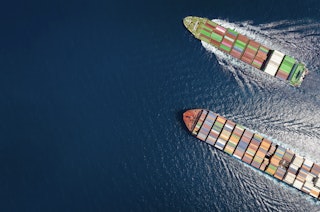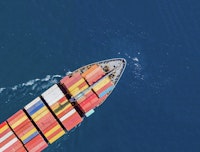Nearly two years after the European Commission proposed to extend the scope of the EU Emissions Trading System to cover greenhouse gas emissions from maritime transport, the EU legislative bodies have finally adopted a revision of the EU ETS. Here is what you need to know about the essential aspects of the new rules, as well as our recommendations on how the shipping industry should prepare for the new emissions trading regime.
This article was updated on 4 December 2024, following the EU Commission's adoption of a new implementing regulation, changing the default responsible party from the Document of Compliance holder to the registered shipowner.
On 14 July 2021, as part of the "Fit for 55" package, the European Commission proposed to revise the EU Emissions Trading System ("EU ETS") to align it with the target of a 55% reduction of greenhouse gas emissions by 2030, compared to 1990 levels. Since its publication, the Commission's proposals have been subject to extensive discussions by the European Parliament and the European Council. Over the last two years, several different proposals on how and when to include emissions from maritime transport in the EU ETS have gone back and forth between the European Commission, the European Council and the European Parliament.
Finally, on 18 April 2023, the European Parliament voted in favour of the proposed revision of the EU ETS. On 25 April 2023, the European Council adopted the key pieces of the "Fit for 55" package, including the revision of the EU ETS.
From 2024, emissions from maritime transport will be included in the EU ETS for the first time, with emission allowances having to be surrendered from 2025. Relevant stakeholders should therefore consider the impact of the new regime before its application from 1 January 2024. In addition, the EU monitoring, reporting and verification (MRV) regulation (Regulation (EU) 2015/757) is being amended to adapt for the extension of the EU ETS to maritime transport activities and to provide for the monitoring, reporting and verification of emissions of greenhouse gases and emissions from additional ship types.
Below, we have highlighted the most important implications that the EU ETS is expected to have for the shipping industry.
Which vessels will fall within the scope of the EU ETS?
- From 1 January 2024, the EU ETS will apply to all cargo vessels and passenger ships over 5,000 gross tonnes sailing to or from EU ports, regardless of flag state or ownership.
- Offshore service vessels of 5,000 gross tonnes or more will be included in the EU MRV regulation from 2025, and in the EU ETS from 2027.
- General cargo vessels and offshore vessels between 400 and 5,000 gross tonnes will be included in the EU MRV regulation from 2024. The European Commission shall review the possibility of including these vessel sizes in the EU ETS and present a report to the European Parliament and to the Council no later than 31 December 2026, in which the possible impact it will have to include these ships in the EU ETS shall be examined.
Which emissions arising from maritime transport will fall within the scope of the EU ETS?
- 100% of the emissions from intra-European routes
- 100% of emissions from ships at berth in EU ports
- 50% of extra-European routes to and from a port within the EU
The emissions covered from 2024 will be carbon dioxide (CO₂) from maritime transport. In addition, methane (CH₄) and nitrous oxides (N₂O) will be included in the EU MRV regulation from 2024, and the EU ETS will be extended to cover methane and nitrous oxides from 2026. The inclusion of methane is particularly important for LNG-fuelled vessels. LNG typically consist of approximately 90% methane, and the challenge with methane lies in the occurrence of "methane slip", which is unburned methane that escapes into the atmosphere.
Further, if the International Maritime Organization ("IMO") does not adopt a global reduction target for international shipping by a market-based mechanism ("MBM") in line with the objectives of the Paris Agreement, and similar to the level of the EU ETS by 2028, the Commission will review whether the EU ETS should cover more than 50% of international emissions from voyages between the EU and third countries after 2028.
Port of Call
Notably, the allocation of allowances and the application of surrender requirements only apply to voyages departing from or arriving at a "port of call" under the jurisdiction of one of the EU Member States. The term "port of call" means the port where a ship stops to load or unload cargo or to embark or disembark passengers, or the port where an offshore ship stops to relieve the crew, but excludes, inter alia, stops for the sole purposes of refuelling, obtaining supplies, relieving crew (other than an offshore ship), dry-docking or repairs etc.
Evasive port calls
In order to avoid evasive port calls outside the EU, the definition of "port of call" also excludes stops of container ships in a neighbouring container transhipment ports outside the EU located less than 300 nautical miles from an EU port. Although the regulation is somewhat ambiguous, such container ships will presumably have to include 50% of the emissions for the voyage from the non-EU "port of call" to the first EU "port of call". By 31 December 2023, the Commission will provide a list of neighbouring container transhipment ports.
However, the geographical scope of the EU ETS could still lead to evasive port calls. Operators may seek to avoid the EU ETS regime by adding a call to a port outside the EU, or changing their routes.
How and when to surrender allowances?
The main practical implication of the EU ETS is that shipping companies will have to surrender emission allowances by 30 September every year as follows:
- In 2025, 40% of their verified emissions in 2024
- In 2026, 70% of their verified emissions in 2025
- In 2027 and onwards, 100% of verified emissions in 2026 (and each year after that)
The monitoring and reporting of greenhouse gas emissions shall be verified in accordance with the rules laid down in the EU MRV regulation. The monitoring and reporting shall cover CO₂ emissions from the combustion of fuels while the ships are at sea as well as at berth.
In contrast to the aviation sector, maritime transport will not receive free allocation of allowances nor be protected by the EU's Carbon Border Adjustment Mechanism ("CBAM").
Emission allowances can be bought and sold on the market. The market price of allowances is driven by supply and demand, and primarily reflects the cost of reducing emissions across the various industry areas. Allowances can be purchased at auctions arranged several times a year by the European Energy Exchange ("EEX") or by trading on the secondary market through brokers or online trading platforms. It is also possible to store allowances for future use, as allowances issued on or after 1 January 2013 do not expire until they are surrendered.
Who is responsible?
The "shipping company" is responsible for complying with the EU ETS legislation and surrendering the correct amount of allowances. The shipping company was defined as:
"the shipowner or any other organisation or person, such as the manager or the bareboat charterer, that has assumed the responsibility for the operation of the ship from the shipowner and, by doing so, has agreed to take over all the duties and responsibilities imposed by the International Management Code for the Safe Operation of Ships and for Pollution Prevention" (i.e. the ISM Code).
The definition is based on the definition of "company" in the EU MRV regulation. The proposal was that the entity responsible for submitting emissions data under EU MRV and submission of allowances under EU ETS should be the same, namely the holder of the Document of Compliance under the ISM Code.
However, in a Commission Implementing Regulation, the responsible party under the EU ETS has been changed from the holder of the Document of Compliance under the ISM Code to the registered shipowner. The responsibility may be delegated by agreement to the Document of Compliance holder, which would often be either the technical manager or a bareboat charterer.
As the party responsible for EU ETS should be the same party that is responsible for EU MRV, this may mean that the registered shipowner would also become responsible for compliance with EU MRV by default.
The EU Commission has announced it will produce a list of "shipping companies" before 1 February 2024, which will attribute the shipping companies to Administering Authorities in the various Member States. After that, the list is supposed to be updated every second year, the first time being 1 February 2026.
In line with the "polluter pays" principle, the new rules will oblige the Member States to take the necessary measures to ensure that when the ultimate responsibility for the purchase of fuel, or the operation of the ship, or both, is assumed by an entity other than the "shipping company" pursuant to a contractual arrangement, the "shipping company shall be entitled to reimbursement from that entity for the costs arising from the surrender of allowances. It is thus contemplated a right of direct action by the "shipping company" against the party contractually responsible for the purchase of fuel and/or the operation of the ship, e.g. a charterer. This will require new legislation in many jurisdictions.
For example, if responsibility is delegated to a technical manager, the technical manager will not normally be entitled to claim reimbursement or damages directly from a charterer, with which the manager has no contractual relationship. Despite any such legislation, the "shipping company" will remain the responsible entity for surrendering allowances.
Parties to whom the EU ETS applies to, who wish to allocate the costs for obtaining and submitting the allowances, penalties and other losses that may occur under the EU ETS regime, will need to include specified provisions in their contracts to ensure adequate coverage. BIMCO has published its standard clause Emission Trading Scheme Allowances Clause for Time Charter Parties 2022 for incorporation into new and existing time charter parties. The overall division of responsibility is that the owner is responsible for the compilation and reporting of emission data and the charterer is responsible for providing and paying for the emission allowances.
Sanctions in case of failure to comply with the EU ETS
A shipping company's failure to surrender emission allowances is subject to sanctions. The penalty will be €100 per tonne of uncovered CO₂ equivalent emitted. In addition, the shipping company must surrender the missing emission allowances in the following reporting period.
Further, in the case a shipping company has failed to comply with its obligations to surrender allowances for two or more consecutive reporting periods (and other sanctions have failed to ensure compliance), the competent authority of the port of entry may issue an expulsion order, which not only applies to the vessel in question but covers the whole fleet of the shipping company concerned. The exculpation order will apply to all EU ports except those in the ship's flag state. If the vessel enters a port of its flag state, the ship shall be detained until the shipping company has confirmed the fulfilment of the obligations to surrender allowances by providing a valid document of compliance to the competent national authority that issued the expulsion order. The expulsion order will remain until this is done.
Status in the EU
The final acts were signed on 10 May 2023 and published in the Official Journal on 16 May 2023.
Norway's position
Although Norway's Minister of Climate and Environment, Espen Barth Eide, originally stated on 2 February 2023 that it will be challenging for Norway to meet the requirements from 1 January 2024, legislative work in the Norwegian Parliament (Stortinget) is now underway to be implemented by the end of the year.
It is not yet clear whether the latest change of default responsible party will be reflected in the Norwegian legislation from 1 January 2024.
Thommessen is monitoring the development in the EU and Norway.
Practical implications and our recommendations
As it is now finally decided that emissions from maritime transportation will be included in the EU ETS, shipowners, charterers, managers, and other stakeholders should start preparing to comply with the requirements swiftly and consider how the new legislation will impact their business.
Delegate responsibility under EU ets
Registered shipowners who do not wish to be responsible for compliance with the EU ETS have to prepare a mandate letter which must be signed by both the shipowner and the Document of Compliance holder who will assume the responsibility. This letter should be submitted to the Administrative Authority.
The mandate letter has certain requirements which must be included in order for it to be valid.
Thommessen is currently assisting shipowners with preparing compliant mandate letters to transfer the responsibility prior to the attribution to Member States on 1 February 2024.
Emission Trading Allowances Clause for Time Charters
The purchase of allowances under the EU ETS can be a significant expense for the party (ultimately) liable to pay for the allowances and is likely to affect the pricing and other terms of contractual agreements between parties in the maritime sector. For example, we now see that time charters more frequently include a clause that requires the charterer to bear the costs related to compliance with the EU ETS, such as BIMCO's Emission Trading Scheme Allowances Clause for Time Charter Parties 2022. As it is the time charterer who commercially operates the ship that leads to emissions, we recommend that all time charters that commence after 1 January 2024 include a clause that allocates the costs and responsibilities under the EU ETS (as well as other potential future emissions trading schemes) to the charterer. Ongoing charters with a charter period that continues after 1 January 2024 should be assessed and if possible, renegotiated to the extent appropriate.
EMISSIONS TRADING ALLOWANCE CLAUSE FOR MANAGEMENT AGREEMENTS
BIMCO is also in the process of preparing an Emissions Trading Allowance Clause for management agreements. The clause will be published as a standalone version for use with SHIPMAN 2009 and will be incorporated in the 2023 edition of SHIPMAN. In light of the most recent development wherein the registered shipowner will become the default responsible party, it may be necessary to re-draft the Emission Trading Allowance Clause to reflect this.
open an account to be able to buy, trade and surrender allowances
It is the shipping company that must submit allowances, and the shipping company will have to open an account with the relevant EU/EEA state's EU ETS registry in order to be able to buy, trade and surrender allowances. In Norway, the Norwegian Environment Agency (Nw. Miljødirektoratet) will be the relevant authority responsible for the registry.
The exact process for registration may vary between the states and we would recommend shipping companies to contact the relevant administering authority for guidance on how to set up an account.
Every registered party will have a "maritime operator holding account". This account has different functionalities.
First of all, the account may be used for entering and verification of emissions, if the entity has emissions to register. A negative emissions balance will then appear on this account during the year, based on the reported emissions data for the entity. The verifier will have access to the data, and the verification will also be added to this account.
Secondly, the account may be used for dealing with emission allowances. Allowances may be transferred and surrendered from this type of account.
In addition, it is possible to open a "trading account" purely for the purpose of trading in emissions allowances. This type of account does not have any emissions data connected to it and can also be opened by an entity that does not participate in the EU ETS. There are no restrictions on what kind of transfers that may be made to and from this type of account, but as such an account has no connection with the emissions data, it is not possible to surrender allowances from a trading account.

 Henrik Hagberg
Henrik Hagberg


